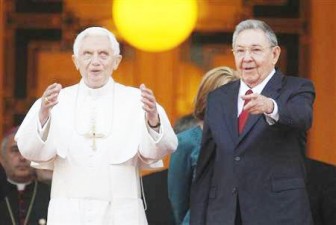HAVANA, (Reuters) – This week’s three-day visit to Cuba by Pope Benedict marked another milestone in the Roman Catholic Church’s cautious efforts to expand its role in the communist-run island.

Havana’s Cardinal Jaime Ortega called it a “Springtime of faith.”
While it remains unclear if or how the visit will change anything in Cuba, most analysts agree any notion of a ‘Cuban spring’ in terms of political change is still a long way off.
Even so, the visit seems to have ensured a growing role for the Church in Cuban society and politics, a potentially significant shift in the balance of forces in a country where religious faith was once scorned.
“The Catholic Church in Cuba has taken on a larger role. For the first time it is in a direct dialogue with the government, direct dialogue having to do with domestic policies,” said Philip Peters, a Cuba expert and vice president at the Lexington Institute, a Virginia-based think tank who attended Wednesday’s Havana Mass. “The Church is pushing more and deeper economic reforms. The Church is also pushing for political openings.”
The Church hopes primarily that the papal visit will help spark a spiritual revival in Cuba, where religious faith was stigmatized for decades after the 1959 revolution. Despite that, a much diminished Church survived and remains the largest and most socially influential institution outside of the government, a fact that Cuban leaders now seem more willing than ever to recognize – and perhaps reward.
Pope Benedict used the trip to deliver a shopping list of requests in talks with Raul Castro on Tuesday, including official recognition of Good Friday – barely a week away – as a national holiday, as well as pressing for greater access to the media and the right to open religious schools.
In fact, the Church has in recent years taken some baby steps in the field of education by offering after-school programs at a handful of churches, as well as university classes offered by a Spanish Catholic order, the Escalapios.
Late last year the government even allowed the Church to open a part-time Master’s in Business Administration program at a Havana seminary with the help of Catholic University professors from Spain.
Start of thaw
Benedict’s visit came 14 years after Pope John Paul’s groundbreaking trip in 1998, which many Cubans say was the beginning of the thaw in church-state relations.
While Fidel Castro received the pope warmly in 1998, his brother and current president, Raul Castro, was even more attentive on this latest papal visit, attending the two Masses celebrated by Benedict, seated in the front row.
Critics, especially the hard-line Cuban-American exiles in Miami, as well as some human rights activists in Cuba, consider the transformation in church-state relations an unholy marriage of convenience, opening the Church up to accusations of not doing enough to defend the human rights of the island’s political dissidents, who the Cuban government considers as mercenaries of the United States.
The Church argues that its engagement with the government is a necessary acceptance of Cuba’s political reality. “The church is not going to dismiss a political system outright. The church will always work within the constraints of a system to find ways to improve human life and dignity,” said Father Juan Molina, director for Latin America affairs at the US Conference of Catholic Bishops.




